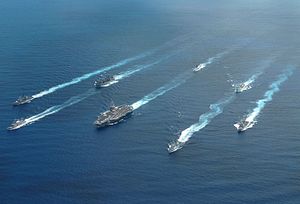China is participating in RIMPAC 2014 for the first time this year. The exercise is the largest naval exercise of its sort in the world and will take place from June 26 to August 1. This year’s exercise will involve 47 surface ships, six submarines, over 200 aircraft, and 25,000 troops. While Chinese media was content to criticize RIMPAC in the past as a blatant attempt at U.S.-led containment given Beijing’s exclusion, news that China would be invited on a roughly equal footing this year has somewhat placated critics. However, while Beijing’s participation in the exercise is noteworthy, will it actually led to less tension in the U.S.-China relationship?
For the United States, including China in RIMPAC seemed to be on the cards at least since 2010 when the exercise began growing rather quickly. While 14 nations participated in RIMPAC in 2010, 2012’s iteration ended up with 22 participants. It was only a matter of time before either the exercise began being perceived as intolerably exclusionary by China or the United States ended up inviting Beijing. The invitation wasn’t begrudging either. The United States has a stated goal of increasing military-to-military ties with China, particularly the People’s Liberation Army Navy (PLAN). Doing so abets transparency and can help prevent misunderstandings between their two militaries.
Still, having China participate in RIMPAC has little tangible benefit. Sure, it is another bullet point to add to the list of “military-to-military contacts between the armed forces of the United States and the People’s Republic of China” section of the Department of Defense’s 2014 annual report, but it counts for little when it comes to reducing tensions. In reality, a lot has transpired between the U.S., China, and other RIMPAC participant states since the PLAN confirmed that it would be participating in this year’s exercise. The invitation was originally extended in 2012 by then-Defense Secretary Leon Panetta. Since then, Beijing has entirely changed the manner in which it is perceived by Asian states along the first island chain. Many U.S. allies in the region are so deeply skeptical of Beijing’s intentions for Asia’s maritime commons that it will take more than token gestures like RIMPAC to help ease tensions.
The only convincing explanation for why China’s participation in RIMPAC is noteworthy is because it allows the United States to practice what it preaches in terms of military transparency and undermining Beijing’s constant “containment” claims. Additionally, the PLAN’s participation in the exercise is ultimately positive sum both in terms of preferences and in terms of outcomes. China is happy because it is included in a major naval exercise involving many regional countries — its participation highlights its prestige as a seafaring nation. The U.S. comes off looking more like a benevolent and inclusive leader than the exclusionary hegemon of an anti-China coalition in Asia. In terms of outcomes, improving interoperability among the navies participating in RIMPAC is also a worthwhile goal considering the potential for these countries to work together in disaster relief operations in the future.
Ultimately, China’s participation in RIMPAC this year won’t result in major changes in terms of how it interacts with its neighbors in Asia’s inner seas or how its leaders perceive the United States’ role in Asia. It’ll take much more than inviting the PLAN to a naval exercise to convince China’s strategic elites to abandon their near-unanimous belief that the U.S. is out to contain China’s rise.

































